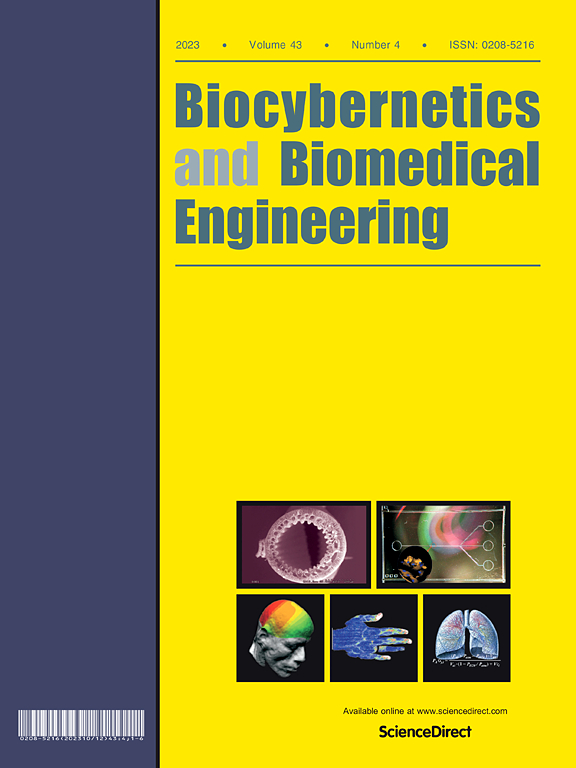评估肌间一致性对糖尿病周围神经病变的早期检测:一项横断面研究
IF 6.6
2区 医学
Q1 ENGINEERING, BIOMEDICAL
引用次数: 0
摘要
糖尿病(DM)是一种以胰岛素不足或胰岛素抵抗引起的慢性高血糖为特征的全球性流行病。糖尿病周围神经病变(DPN)是糖尿病的常见并发症,影响高达50%的患者。它通常表现为远端,对称,长度依赖的神经病变。DPN的早期发现对于减轻其对生活质量和医疗保健费用的影响至关重要。虽然目前的诊断方法,如神经传导研究有局限性,但表面肌电图(sEMG)显示出其无创、实时的神经肌肉评估的前景。本研究探讨了肌电图的潜力,特别是通过肌间一致性,作为早期DPN检测的敏感生物标志物。基于多变量自回归(Multivariate Autoregressive, MVAR)模型分析了3组人群的两个相干参数,部分相干(partial coherence, PC)和部分定向相干(partial directed coherence, PDC): 33名健康志愿者(CT)、10名低风险糖尿病患者(LW)和17名中/高危患者(MH)。在早期DPN中,与对照组相比,协同肌对显示出更高的PC和PDC值,可能是由于神经系统内的神经元高兴奋性和代偿机制。相比之下,DPN晚期表现出连贯性降低,反映了神经纤维丢失和中枢神经系统(CNS)损伤,可能因脊髓萎缩等中枢神经系统的结构性改变而加剧,影响了神经的可塑性和适应性。我们的研究发现背伸肌对,特别是在PDC参数的10-50 Hz带宽,可以有效地区分DPN的分期,三组之间的差异有统计学意义。这表明它有潜力作为DPN的早期检测生物标志物和监测疾病进展。本文章由计算机程序翻译,如有差异,请以英文原文为准。
Assessment of the intermuscular coherence for the early detection of diabetic peripheral neuropathy: a cross-sectional study
Diabetes mellitus (DM) is a global epidemic marked by chronic hyperglycaemia due to insulin insufficiency or resistance. Diabetic peripheral neuropathy (DPN) is a common complication of diabetes, affecting up to 50 % of patients. It typically presents as a distal, symmetric, length-dependent neuropathy. Early detection of DPN is crucial to mitigate its impact on quality of life and healthcare costs. While current diagnostic methods like nerve conduction studies have limitations, surface electromyography (sEMG) shows promise for its non-invasive, real-time neuromuscular assessments. This study explores the potential of sEMG, particularly through intermuscular coherence, to serve as a sensitive biomarker for early DPN detection. Two coherence parameters, partial coherence (PC) and partial directed coherence (PDC), based on the Multivariate Autoregressive (MVAR) models have been analysed in three population groups: 33 healthy volunteers (CT), 10 diabetic patients with a low risk of DPN (LW), and 17 moderate/high-risk patients (MH). In early-stage DPN, synergistic muscle pairs showed increased PC and PDC values compared to controls, likely due to neuronal hyperexcitability and compensatory mechanisms within the nervous system. In contrast, advanced DPN stages exhibited reduced coherence, reflecting nerve fiber loss and central nervous system (CNS) impairment, possibly exacerbated by structural CNS changes like spinal cord atrophy, affecting neural plasticity and adaptation. Our study found that the dorsiflexor muscle pair, especially in the bandwidth 10–50 Hz of the PDC parameter, effectively discriminated between DPN stages, distinguishing all three groups with statistical significance. This suggests its potential as an early detection biomarker for DPN and for monitoring disease progression.
求助全文
通过发布文献求助,成功后即可免费获取论文全文。
去求助
来源期刊

Biocybernetics and Biomedical Engineering
ENGINEERING, BIOMEDICAL-
CiteScore
16.50
自引率
6.20%
发文量
77
审稿时长
38 days
期刊介绍:
Biocybernetics and Biomedical Engineering is a quarterly journal, founded in 1981, devoted to publishing the results of original, innovative and creative research investigations in the field of Biocybernetics and biomedical engineering, which bridges mathematical, physical, chemical and engineering methods and technology to analyse physiological processes in living organisms as well as to develop methods, devices and systems used in biology and medicine, mainly in medical diagnosis, monitoring systems and therapy. The Journal''s mission is to advance scientific discovery into new or improved standards of care, and promotion a wide-ranging exchange between science and its application to humans.
 求助内容:
求助内容: 应助结果提醒方式:
应助结果提醒方式:


